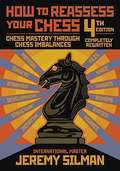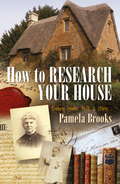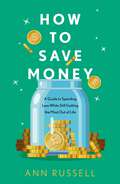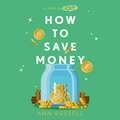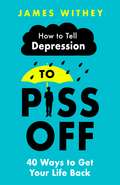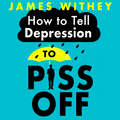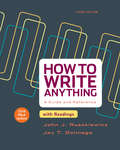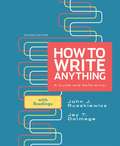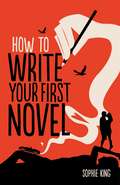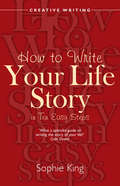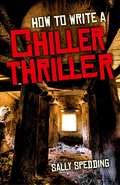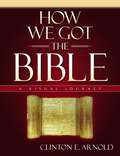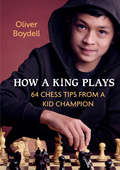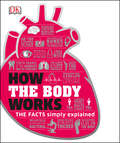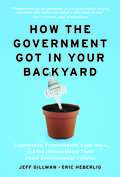- Table View
- List View
How To Reassess Your Chess: Chess Mastery Through Chess Imbalances
by Jeremy SilmanHow to Reassess Your Chess has long been considered a modern classic. This fourth and final edition completely rewritten and featuring all new examples takes Silman's groundbreaking concept of imbalances to a whole new level. Designed for players in the 1400 to 2100 rating range and for teachers looking for a ready-made chess curriculum, the author shares a mind-expanding journey that takes the reader through imbalance-basics, ensures that every detail of all the imbalances are mastered, and leaves the player/lover of chess with something he always wanted but never believed he could achieve: a master-level positional foundation. <P><P>A section on practical chess psychology (titled Psychological Meanderings) presents never-before-published ideas on psychological processes that hinder players of all levels, and gives easy-to-follow advice and techniques that will help anyone overcome these ubiquitous mental/emotional failings. <P><P>Hundreds of games brought to life by instruction-rich prose, and stories that offer humor while highlighting various lessons, vividly illustrate all the book's topics in a manner that's both personal and fun. <P><P>If the positional masterpieces of the chess legends have always been a mystery to you, if chess strategy has always been an unsolvable enigma, if you find yourself a positional pawn rather than a positional master, then How to Reassess Your Chess, 4th edition will prove to be a life-changing experience. <P><P>Jeremy Silman is an International Master and a world-class teacher, writer, and player who has won the American Open, the National Open, and the U.S. Open. Considered by many to be the game's preeminent instructive writer, he is the author of over thirty-seven books, including Silman's Complete Endgame Course, The Amateur's Mind, The Complete Book of Chess Strategy, and The Reassess Your Chess Workbook. His website (www.jeremysilman.com) offers fans of the game instruction, book reviews, theoretical articles, and details
How To Research Your House: Every Home Tells a Story...
by Ms Pamela BrooksDo you want to know more about the history of your house, find out about the lives of former inhabitants, and discover more about the local community in which your house stands? Pamela Brooks, author of "How to Research Local History" will help you get started. She'll take you step by step along a fascinating trail of discovery, starting with the building itself and progressing to who lived there.Contents: 1. Introduction; 2. Preparing to research; 3. Secondary sources; 4. The Architecture of Your House - External Features; 5. The Architecture of Your House - Internal Features; 6. The building itself: Maps, Photographs and Sketches; 7. The Building Itself: Other Documents; 8. Who Lived There? Deeds and Taxation Records; 9. Who lived there? Personal Records; 10. Other sources; Appendices; Index.
How To Research Your House: Every Home Tells a Story...
by Pamela BrooksDo you want to know more about the history of your house, find out about the lives of former inhabitants, and discover more about the local community in which your house stands? Pamela Brooks, author of "How to Research Local History" will help you get started. She'll take you step by step along a fascinating trail of discovery, starting with the building itself and progressing to who lived there.Contents: 1. Introduction; 2. Preparing to research; 3. Secondary sources; 4. The Architecture of Your House - External Features; 5. The Architecture of Your House - Internal Features; 6. The building itself: Maps, Photographs and Sketches; 7. The Building Itself: Other Documents; 8. Who Lived There? Deeds and Taxation Records; 9. Who lived there? Personal Records; 10. Other sources; Appendices; Index.
How To Save Money: A Guide to Spending Less While Still Getting the Most Out of Life
by Ann RussellWith the recent cost of living crisis, we are all looking for ways to cut bills and save money. Ann Russell, who is best known as "TikTok's Auntie", has lived much of her life on a tight budget, and since energy bills first started rising, has been answering fan's questions not just about cleaning but about all kinds of ways to economise. Following on from her first book, How To Clean Everything, in How To Save Money Ann will share her advice on the best ways to save money and cut back in all sorts of areas, covering everything from budgeting to meal planning and reducing food waste, and from tips on spending less each month to the most energy efficient ways to heat your house, do your laundry etc. Written with Ann's trademark warmth, humour and understanding, this is a book that will help everyone who is looking to spend less while still getting the most out of life.
How To Save Money: A Guide to Spending Less While Still Getting the Most Out of Life
by Ann RussellWith the recent cost of living crisis, we are all looking for ways to cut bills and save money. Ann Russell, who is best known as "TikTok's Auntie", has lived much of her life on a tight budget, and since energy bills first started rising, has been answering fan's questions not just about cleaning but about all kinds of ways to economise. Following on from her first book, How To Clean Everything, in How To Save Money Ann will share her advice on the best ways to save money and cut back in all sorts of areas, covering everything from budgeting to meal planning and reducing food waste, and from tips on spending less each month to the most energy efficient ways to heat your house, do your laundry etc. Written with Ann's trademark warmth, humour and understanding, this is a book that will help everyone who is looking to spend less while still getting the most out of life.
How To Save Money: A Guide to Spending Less While Still Getting the Most Out of Life
by Ann RussellA guide to living more frugally, from everyone's favourite 'TikTok Auntie'.With the recent cost of living crisis, we are all looking for ways to cut bills and save money. Ann Russell, who is best known as "TikTok's Auntie", has lived much of her life on a tight budget, and since energy bills first started rising, has been answering fan's questions not just about cleaning but about all kinds of ways to economise. Following on from her first book, How To Clean Everything, in How To Save Money Ann will share her advice on the best ways to save money and cut back in all sorts of areas, covering everything from budgeting to meal planning and reducing food waste, and from tips on spending less each month to to the most energy efficient ways to heat your house, do your laundry etc. Written with Ann's trademark warmth, humour and understanding, this is an audiobook that will help everyone who is looking to spend less while still getting the most out of life.(P) 2023 Headline Publishing Group Ltd
How To Tell Depression to Piss Off: 40 Ways to Get Your Life Back
by James WitheyDepression sucks, but you don't.Trying to manage the range of symptoms that depression throws at you is like navigating the dark ocean floor when you are without a torch and don't know how to swim. How do you manage something that feels utterly unmanageable? How do you get through each day when depression is telling you you're a worthless lump of camel spleen? What you need is a guide. A really good one. You need to know what works and what to do.This book gives you 40 ways to get to a better place with depression. They are born out of the author's personal experience of clinical depression and his many years of working as a counsellor helping people with their mental health. James lives with depression and knows its lies, the traps it makes and how to dodge when it starts spitting bile in your face. Nice, eh?The ways include:- Kick your cuckoo. We don't usually encourage violence towards birds, but no cuckoos are actually harmed so don't call the RSPCA just yet. In this chapter you're encouraged to imagine your depression as an external 'thing' (no humans or animals, of course!) and that you can 'kick out', which is great fun. - Whose voice is it anyway? Spoiler alert! That nasty voice you're hearing isn't you; it's depression. The illness. When you start to recognise its voice you can start swearing back and who doesn't love a bit of swearing?- Don't listen to the lies. We all tell little lies sometimes, right? But depression is the biggest liar in the whole universe. It makes Pinocchio look like Mother Theresa. Be the lie detector to depression's fibs; call it out on its fraudulent nonsense. - Do the opposite. Depression will try to convince you to stay in bed, don't go out, don't wash, don't eat, don't phone anyone. Be Contrary Mary and do the exact opposite of what depression tells you because it never has your interests at heart. Plus, doing the opposite feels like you're a rebel, and rebels are cool (see Star Wars). At whatever point you're at with your depression, this book can help and provide some laughs along the way - hooray! - because you really need it with this bloody illness.
How To Tell Depression to Piss Off: 40 Ways to Get Your Life Back
by James WitheyDepression sucks, but you don't.Trying to manage the range of symptoms that depression throws at you is like navigating the dark ocean floor when you are without a torch and don't know how to swim. How do you manage something that feels utterly unmanageable? How do you get through each day when depression is telling you you're a worthless lump of camel spleen? What you need is a guide. A really good one. You need to know what works and what to do.This book gives you 40 ways to get to a better place with depression. They are born out of the author's personal experience of clinical depression and his many years of working as a counsellor helping people with their mental health. James lives with depression and knows its lies, the traps it makes and how to dodge when it starts spitting bile in your face. Nice, eh?The ways include:- Kick your cuckoo. We don't usually encourage violence towards birds, but no cuckoos are actually harmed so don't call the RSPCA just yet. In this chapter you're encouraged to imagine your depression as an external 'thing' (no humans or animals, of course!) and that you can 'kick out', which is great fun. - Whose voice is it anyway? Spoiler alert! That nasty voice you're hearing isn't you; it's depression. The illness. When you start to recognise its voice you can start swearing back and who doesn't love a bit of swearing?- Don't listen to the lies. We all tell little lies sometimes, right? But depression is the biggest liar in the whole universe. It makes Pinocchio look like Mother Theresa. Be the lie detector to depression's fibs; call it out on its fraudulent nonsense. - Do the opposite. Depression will try to convince you to stay in bed, don't go out, don't wash, don't eat, don't phone anyone. Be Contrary Mary and do the exact opposite of what depression tells you because it never has your interests at heart. Plus, doing the opposite feels like you're a rebel, and rebels are cool (see Star Wars). At whatever point you're at with your depression, this book can help and provide some laughs along the way - hooray! - because you really need it with this bloody illness.
How To Tell Depression to Piss Off: 40 Ways to Get Your Life Back
by James WitheyDepression sucks, but you don't.Trying to manage the range of symptoms that depression throws at you is like navigating the dark ocean floor when you are without a torch and don't know how to swim. How do you manage something that feels utterly unmanageable? How do you get through each day when depression is telling you you're a worthless lump of camel spleen? What you need is a guide. A really good one. You need to know what works and what to do.This book gives you 40 ways to get to a better place with depression. They are born out of the author's personal experience of clinical depression and his many years of working as a counsellor helping people with their mental health. James lives with depression and knows its lies, the traps it makes and how to dodge when it starts spitting bile in your face. Nice, eh?The ways include:- Kick your cuckoo. We don't usually encourage violence towards birds, but no cuckoos are actually harmed so don't call the RSPCA just yet. In this chapter you're encouraged to imagine your depression as an external 'thing' (no humans or animals, of course!) and that you can 'kick out', which is great fun. - Whose voice is it anyway? Spoiler alert! That nasty voice you're hearing isn't you; it's depression. The illness. When you start to recognise its voice you can start swearing back and who doesn't love a bit of swearing?- Don't listen to the lies. We all tell little lies sometimes, right? But depression is the biggest liar in the whole universe. It makes Pinocchio look like Mother Theresa. Be the lie detector to depression's fibs; call it out on its fraudulent nonsense. - Do the opposite. Depression will try to convince you to stay in bed, don't go out, don't wash, don't eat, don't phone anyone. Be Contrary Mary and do the exact opposite of what depression tells you because it never has your interests at heart. Plus, doing the opposite feels like you're a rebel, and rebels are cool (see Star Wars). At whatever point you're at with your depression, this book can help and provide some laughs along the way - hooray! - because you really need it with this bloody illness.
How To Win Your 1st Election
by Susan GuberWhen this book was first published in 1987, many first-time candidates unabashedly referred to it as "the Bible." Now in a new, updated edition, How to Win Your 1st Election is a step-by-step guide to the entire campaign process, from raising funds right through handling election-day jitters. Want to know where to put up signs? What to say at a candidates' forum? How to dress to make the best possible impression? Let Susan Guber, who beat out seven other candidates in her first election, show you the way. How to Win Your 1st Election is an ideal book for aspiring candidates, campaign managers, public relations consultants and students of political science and U.S. government. Written in a clear, easy-to-read style, it devotes entire chapters to topics such as hiring staff, managing the media, creating a public image, writing and delivering speeches, and campaign ethics. What's more, it's one of the few books out there that offers a full, comprehensive look at our country's unique electoral system-as seen through the eyes of an experienced insider. Susan Guber put this information to work for herself in three successful campaigns. Won't you try the same?
How To Write A Page-Turner: Craft a Story Your Readers Can't Put Down
by Jordan RosenfeldInfuse Your Fiction with the Powerful Tug of Tension! Tension is the heart of conflict, the backbone of uncertainty, the hallmark of danger. It keeps readers guessing and characters on their toes. When you've got tension in place, stories leave readers breathless and wanting more. When it's missing, scenes feel inconsequential, plots drag, and characters meander. Learning the craft of writing can sometimes feel like a paint by numbers approach--connect compelling character A to plot event B. To avoid writing that's formulaic, predictable, and slow, How to Write a Page Turner will help you sew the threads of tension tight for an unforgettable story. You'll learn how to:Recognize the essential tension elements of danger, conflict, uncertainty, and withholding, and add them to your fictionCreate levels of tension in your characters through flaws, dialogue, power struggles, and moreBuild tension at energetic markers throughout the plotUse intimate imagery, strong sentences, and well-chosen words to build tension in expositionWhile this book walks you through the key areas that need tension building, from character to plot, it also delves deeper, analyzing exceptional examples from contemporary fiction's most gripping page-turners. So as you dive into the inner conflicts of a character's deepest psyche, to the mechanics of how you reveal information to the reader, you'll also discover how to craft a story your readers can't put down!
How To Write Anything with Readings with 2016 MLA Update
by John J. Ruszkiewicz Jay T. DolmageTHIS TITLE HAS BEEN UPDATED TO REFLECT THE 2016 MLA UPDATES! Our editorial team has updated this text based on content from The MLA Handbook, 8th Edition. Browse our catalog or contact your representative for a full listing of updated titles and packages, or to request a custom ISBN. Instructors at hundreds of colleges and universities have turned to How to Write Anything for clear, focused writing advice that gives students just what they need, when they need it. And students love it—because John Ruszkiewicz’s tone makes writing in any genre approachable, with a flexible, rhetorical framework for a range of common academic and real-world genres, and a reference with extra support for writing, research, design, style, and grammar. The new edition also gives students more support for writing portfolios, more help working with the concept of genre, and more emphasis on critical reading and writing—all essential to academic success. And you’ll find more teaching ideas and syllabi from the community of teachers led by coauthor Jay Dolmage. The result is everything you need to teach composition in a flexible and highly visual guide, reference, and reader.
How To Write Anything: A Guide and Reference with Readings
by John J. Ruszkiewicz Jay T. DolmageHow to Write Anything supports students wherever they are in their writing process. Designed to be clear and simple, the Guide lays out focused advice for writing common academic and real-world genres, while the Reference covers the range of writing skills that students needs as they work across genres and disciplines. Genre-based readings -- including narratives, reports, arguments, evaluations, proposals and rhetorical, causal, and literary analyses -- are sure to engage students and inspire ideas. The result is everything you need to teach composition in a flexible, highly visual guide, reference and reader. This new edition gives students more support for academic writing, more help choosing and working with genres, and more emphasis on multimodal composing.
How To Write Your First Novel
by Sophie KingLet best-selling novelist Sophie King guide you through the whole process of writing your first novel and getting it published.This revised edition takes aspiring novelists through the steps of writing a novel, from finding that initial idea, to keeping the plot going and crafting the perfect ending. With helpful exercises in each chapter you will learn how to:- Develop a brilliant idea for your first novel - Create characters that will make your novel come alive - Plot your novel so that your readers simply have to turn the page - Unravel the mysteries of viewpoint - Create realistic dialogue and settings so your readers feel they are there - Find your own voice. - Most importantly, the book includes tips and advice on how to get published. This new edition also includes a ten step guide to revision so that you can polish your novel to be the best it can be.
How To Write Your Life Story in Ten Easy Steps: 'what Splendid Guide To Writing The Story Of Your Life!'
by Sophie KingWriting your life story is one of the greatest gifts you can give your family. In writing it you will find yourself drawing even closer to your children and grandchildren. You will also find it an exciting and fascinating process, one that helps you to make sense of your own life. Writing your own life story is also a very good way for creative writers to find inspiration and get started in the habit of writing. This step-by-step guide will steer you through different ways of telling your life story, in ten easy steps: * HOW TO BEGIN * USING THE POWER OF MEMORY * HOW TO START YOUR RESEARCH * DIFFERENT WAYS OF STRUCTURING YOUR LIFE STORY * HOWTO MAKE YOUR LIFE STORY STAND OUT WITH PICTURES, COLOURS AND SMELLS, ETC * HOW TO PROVIDE A CONTEMPORARY FEEL TO YOUR LIFE STORY * BRINGING THE REST OF THE WORLD INTO YOUR STORY * HOWTO END YOUR LIFE STORY AND MAKE SURE THAT IT DOESN T HURT ANYONE (INCLUDING YOURSELF) * HOW TO PRESENT YOUR LIFE STORY AND GET IT PUBLISHED *STORIES TO INSPIRE YOU / Nowadays, you can publish your life story should you want to do so. For a small amount of money, you can get a few bound copies or you can publish it free on the net. Don’t miss this wonderful opportunity to write an heirloom which will last for ever.
How To Write Your Life Story in Ten Easy Steps: 'what Splendid Guide To Writing The Story Of Your Life!'
by Sophie KingWriting your life story is one of the greatest gifts you can give your family. In writing it you will find yourself drawing even closer to your children and grandchildren. You will also find it an exciting and fascinating process, one that helps you to make sense of your own life. Writing your own life story is also a very good way for creative writers to find inspiration and get started in the habit of writing. This step-by-step guide will steer you through different ways of telling your life story, in ten easy steps: * HOW TO BEGIN * USING THE POWER OF MEMORY * HOW TO START YOUR RESEARCH * DIFFERENT WAYS OF STRUCTURING YOUR LIFE STORY * HOWTO MAKE YOUR LIFE STORY STAND OUT WITH PICTURES, COLOURS AND SMELLS, ETC * HOW TO PROVIDE A CONTEMPORARY FEEL TO YOUR LIFE STORY * BRINGING THE REST OF THE WORLD INTO YOUR STORY * HOWTO END YOUR LIFE STORY AND MAKE SURE THAT IT DOESN T HURT ANYONE (INCLUDING YOURSELF) * HOW TO PRESENT YOUR LIFE STORY AND GET IT PUBLISHED *STORIES TO INSPIRE YOU / Nowadays, you can publish your life story should you want to do so. For a small amount of money, you can get a few bound copies or you can publish it free on the net. Don’t miss this wonderful opportunity to write an heirloom which will last for ever.
How To Write a Chiller Thriller
by Sally SpeddingHave you dreamt of becoming a thriller writer but not dared to do so because of lack of self-belief, or the necessary time, or both? Are you also a thriller reader who has been disappointed by the sameness and lack of ambition in what you've read? If so, this book will help you create chiller thrillers with a difference, with memorable characters and truly chilling plots, drawing not only from the past and present, but the future too. From horror and the paranormal, to equally disturbing scientific and hi-tech developments. Bravery is the key. So, come on board!
How We Eat with Our Eyes and Think with Our Stomach: The Hidden Influences That Shape Your Eating Habits
by Brian Wansink Carolin Sommer Melanie Mühl Diana Von Kopp“Cut through the juice cleanses and paleo diets to bring back some common sense.”—The New York Times Book ReviewOutsmart Your Impulses and Eat Better A Belgian chocolate cake topped with a velvety homemade mousse catches your eye on the menu. The next thing you know, you’ve ordered it—despite the hefty price. But do you know why? Through over 40 compelling questions, this book explores how our eating decisions tread the line between conscious and subconscious, and enables us to be more intelligent about food. With expert insights that draw from psychology, neuroscience, popular culture, and more, learn to see the innumerable influences behind your diet and cravings—from the size and color of your plate, to the placement of products in a supermarket, to the order in which you sit when out with friends. And the chocolate cake? Would you believe research shows that regional descriptions (Belgian!) and emotive, sensory language (homemade! velvety!) subtly affect your appetite? Know what and why you eat, when and how you do—before you next sit down to dine!
How We Got the Bible: A Visual Journey (Zondervan Visual Reference Series)
by Clinton E. ArnoldHow did the Bible come to be? How has it been passed down to us through the ages? Is it still trustworthy and relevant after all these years? The Bible is the bestselling book of all time and the basis of faith for billions of people around the world. Encompassing the fields of archaeology, biblical studies, and history, the story of how the Bible has come to us today is a fascinating one. It is told here, accompanied by beautiful full-color photographs and illustrations. You’ll marvel at the care and reverence with which this ancient book has been preserved. Just a few of the remarkable insights you’ll gain include scriptural origins on animal skins and clay tablets and the discovery of the Dead Sea Scrolls.
How Well Do You Know Your Bible?: Over 500 Questions and Answers to Test Your Knowledge of the Good Book
by James BellA must-read collection for Bible enthusiasts, study groups, and anyone interested in learning more about the most revered book of all time. As the bestselling book in the world, the Bible is a source of faith and enlightenment for millions of people. But how well do you really know its stories?Do You Know: What significant event in Jesus's life happened by the brook Kidron? Though he doesn't identify himself in the book, who is generally considered the author of Mark? What was Paul's side story? What does the name Habakkuk mean? Why did God remove Saul as king and replace him with David?Bible expert James Stuart Bell presents an extensive collection of over five hundred questions and answers designed to help readers deepen their understanding and appreciation of the essential Bible events and lessons. Blending valuable historical context and quizzes from all sixty-six books of the Bible, How Well Do You Know Your Bible? offers a variety of questions for readers to test their knowledge and possibly learn something new along the way.
How Writing Works: A field guide to effective writing
by Roslyn PetelinThis is Roslyn Petelin's promise: whether you already write reasonably well or not, this book will exponentially improve your writing.How Writing Works is a lively and practical introduction to the elements of grammar, sentence structure, and style that you need to write well. The book covers social media and writing for online publication, as well as the most common documents in the university and the writing-reliant workplace.How Writing Works should be on the desk of everyone who needs to write: students, professionals in all fields, and creative writers.'A superb guide to great writing in the modern media era.' Phil Harding, journalist and broadcaster, London'Whether you're a CEO or an intern, the ability to communicate clearly is your biggest asset. Petelin's expert advice in this book will accelerate your career'. Damian Kington, Global Head of Marketing, Liquidnet, New York
How a King Plays: 64 Chess Tips from a Kid Champion
by Oliver BoydellFor fans of The Queen's Gambit comes a brand-new book from 11-year-old chess champion Oliver Boydell. How a King Plays features 64 of Boydell's tips, strategies, and ideas to help chess enthusiasts of all ages sharpen their game skills.Whether you're new to chess or a Grandmaster, there's something for everyone in chess phenom Oliver Boydell's new book of 64 chess tips, How a King Plays. At only 11-years-old, Boydell has already been both a National Chess Champion and a New York City Chess Champion who's competed at numerous major scholastic chess events since he started playing at the age of 5. Now, Boydell is lending his talents to the page as he shares some of his best tips that helped him become a star. Written in his signature concise and witty voice, Boydell offers players of all levels—from beginners to advanced—a different, creative tip on every page. An introduction from the author, inspirational quotes from chess greats, and a glossary of terms help round out this comprehensive and informative, fun guide. Jam-packed with wisdom and imaginative gameplay, this compact and portable reference book can easily be taken on the go to a tournament, to the park, or anywhere you're traveling. How a King Plays is the ideal companion for anyone whose passion for chess can't be contained.
How the Bible Was Formed: A Zondervan Digital Short
by Gregg AllisonDerived from Gregg Allison’s magisterial Historical Theology, this digital short provides a concise but thorough history of how both New Testament and Old Testament books were identified as Scripture and incorporated into the final canon. Attention is paid to differences between the Catholic and Protestant canons and to debates about the inclusion of apocryphal books. The equivalent of a series of lectures on Scripture’s formation, with extensive footnoting for further reading, this digital short provides a one-stop reference resource on a foundational matter of Christian doctrine and worship.
How the Body Works: The Facts Simply Explained (DK How Stuff Works)
by DKThis book takes you on the ultimate anatomical adventure around your own body, revealing how little you know about yourself in mind-blowing depth and detail.As part of the best-selling How Things Work series, this biological bonanza uses dynamic graphics, simple science, and accessible text to explore and explain this tricky subject as never before. If you&’ve ever wondered why your blood is red, how your reflexes work, what makes you feel dizzy, and where exactly are the butterflies in your tummy, then wonder no more. The answers to all these questions and many others are included in this essential visual guide. From body basics to advanced anatomy, How the Body Works introduces all your weird and wonderful parts and processes, alongside fascinating facts and easy explanations across hundreds of pages. Guaranteed to get your brain in gear, you&’ll get to know your physical self in terms of cells, skin, bones, and blood, as well as getting to grips with your emotional side in the psychology of emotions, memories, and dreams. Understand how our bodies keep us alive and thriving with How the Body Works.
How the Government Got in Your Backyard: Superweeds, Frankenfoods, Lawn Wars, and the (Nonpartisan) Truth About Environmental Policies
by Jeff Gillman Eric HeberligBiotechnology—the future or a genetic time bomb? Renewable fuels—the key to cleaner air or just corporate welfare? Greenhouse gasses—baking the earth to death or just a needless worry? Plant patents—improving gardens and farms or just profiteering? When you stop to think about it, the government has its hand in every important environmental issue. And with the left and the right raucously disagreeing about whether the government’s policies are for good or for evil, it’s impossible for a concerned citizen to know what to think.How the Government Got in Your Backyard distills the science, the politics, and the unbiased, nonpartisan truth behind hot-button environmental issues from pesticides to global warming. By clearly representing what the left says, what the right says, what the science is, and what the facts are, Gillman and Heberlig don’t set out to provide the answer—they light the path so concerned citizens can uncover their own true and informed opinion. In this season of political discontent, the unbiased truth about environmental policies—free of political agendas—is as refreshing as it is fascinating.How the Government Got in Your Backyard is not for Republicans or Democrats, liberals or conservatives. It’s for anyone who is ready to get to the bottom line.
